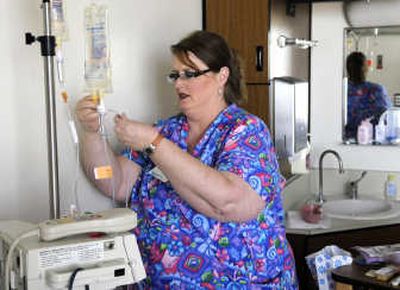Region feels the pain of nursing shortage

Help wanted: Come live, work and play in sunny California. Salary: $80,000. Signing bonus: $10,000. Meaningful employment with excellent benefits and job security.
Such enticing offers for entry-level nurses are fueling staffing shortages at Spokane hospitals, which have been admitting patients at a bed-busting clip this year.
Driving the numbers are a tough flu season, exacerbated by other medical problems including diabetes, pneumonia and heart disease, along with an aging population.
There are more than 110 job openings for registered nurses at Spokane hospitals, which historically have escaped nationwide nursing shortages because of local college programs.
Half of the 350 graduates at Spokane’s Intercollegiate College of Nursing are taking jobs out of state this year, Associate Dean Anne Hirsch said. Though enrollment in the program has nearly doubled in the past seven years, more nurses are needed.
First, though, more professors are needed, Hirsch said. That’s a problem compounded by rising salaries, perks, job variety and scheduling flexibility offered at hospitals and other health care providers.
It’s adding up to a national problem afflicting Spokane.
Shelley Peterson, chief nursing officer at Deaconess Medical Center, acknowledged that Spokane hospitals can’t match the money thrown about by California hospitals, even if Spokane’s lower cost of living makes the bigger money a financial wash.
“Money talks and so do bonuses,” she said.
The need for nurses is affecting how hospitals operate. When there aren’t enough nurses, hospitals can’t use every critical care bed available.
Medical centers across Washington and North Idaho have been diverting patients to other facilities with room, Peterson said.
Mike Wilson, president of Sacred Heart Medical Center, said the region’s largest hospital often has 6 to 8 percent of its nursing positions vacant. The openings are not indicative of a shortage, he said. The hospital is busy and adding nurses to handle the influx of patients. Sacred Heart just hired 36 graduates.
During some days this year, Sacred Heart’s patient census topped 600, Wilson said. The hospital is licensed to operate 623 beds but is not equipped or staffed to handle that many patients without relying on traveling nurses and other temporary workers.
The biggest needs are for experienced nurses in critical care areas, surgery and the emergency room.
Hirsch said there are 5,000 registered nurse openings in Washington.
That’s a daunting number, Hirsch said, because the wave of expected retirements will hit about the time baby boomers are expected to fill hospitals.
A study conducted for the Washington state Department of Health and Washington Center for Nursing found that nursing school graduate numbers are falling behind.
The report stated graduation rates must increase by 400 registered nurses per year in Washington beginning in 2010 to reach the needs of 2021.
The nation’s hospitals will need 2.8 million nurses in 12 years, according to a U.S. Department of Health and Human Services report. That’s 1 million more nurses than this year.
“That’s a lot of nurses,” said Anne Tan Piazza, spokeswoman for the Washington State Nurses Association. “Unfortunately for Spokane, it’s no longer in a bubble.”
Sacred Heart nurse Kathy Ormsby likened the scenario to a perfect storm. Experienced nurses are recruited to places like California and Arizona, she said, when the need for experienced help is so important.
“We are taking care of more patients, sicker patients, and patients with multiple complications,” Ormsby said.
People are living longer with the help of better care and drugs.
But when they get sick, she said, patients are more difficult to treat.
“Some nurses are even leaving the profession because they can’t physically do it anymore,” Ormsby said, saying that many miss meal and rest breaks because of high patient numbers and staffing levels.